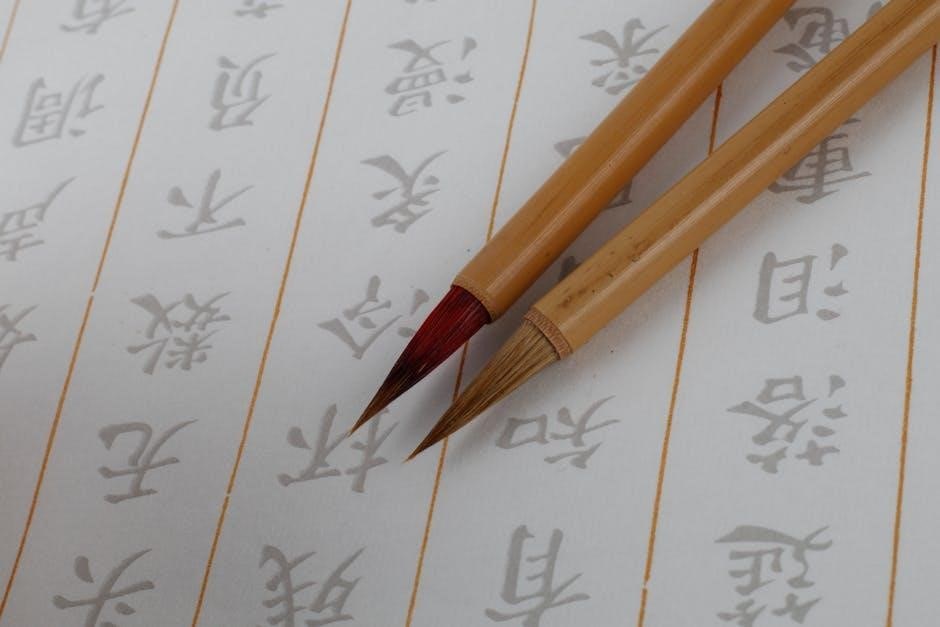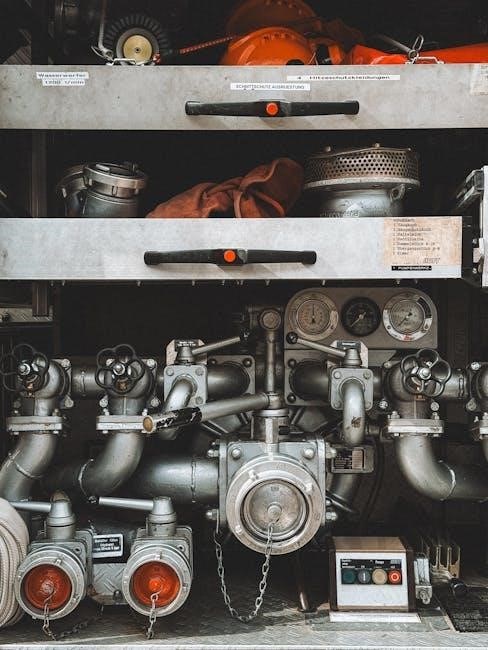Piping and Instrumentation Diagram (P&ID) symbols are essential for process industries, representing equipment, instruments, and controls. They facilitate clear communication among engineers and operators, ensuring system design and operation accuracy.
1.1 Definition and Purpose of P&ID Symbols
P&ID symbols are standardized graphical representations used to depict process equipment, instruments, and control devices. Their primary purpose is to provide a clear, concise visual language for understanding complex systems. These symbols ensure consistency and accuracy in documenting processes, enabling effective communication among engineers, operators, and stakeholders. They are fundamental for designing, operating, and maintaining process plants safely and efficiently.
1.2 Importance of Standardization in P&ID Symbols
Standardization in P&ID symbols ensures consistency and accuracy across designs, reducing interpretation errors. It enables clear communication among engineers, operators, and stakeholders, fostering collaboration and efficiency. Uniform symbols enhance readability, simplify training, and align with industry practices. This consistency is critical for safe and reliable plant operation, as well as compliance with regulatory requirements. Standardized symbols also facilitate efficient project execution and troubleshooting.

Common P&ID Symbols for Equipment
P&ID symbols represent process and mechanical equipment like tanks, vessels, pumps, and valves. These symbols provide a visual language for understanding system layouts and interactions.
2.1 Process Equipment Symbols (e.g., Tanks, Vessels, Heat Exchangers)
Process equipment symbols represent key components in P&IDs, such as tanks, vessels, and heat exchangers. These symbols are standardized to ensure clarity and consistency. Tanks are depicted as rectangular or cylindrical shapes, while vessels are shown with additional details like agitation or internals. Heat exchangers are illustrated with coil or shell-and-tube representations. These symbols are essential for visualizing process flows and equipment interactions in plant designs.
2.2 Mechanical Equipment Symbols (e.g., Pumps, Compressors, Valves)
Mechanical equipment symbols in P&IDs represent devices like pumps, compressors, and valves. Pumps are often shown as circles with internal triangles, while compressors are depicted with multiple rectangles or circles to indicate stages. Valves are illustrated with symbols distinguishing their types, such as gate, globe, or check valves. These symbols are crucial for maintaining clarity and consistency in process system designs, ensuring accurate communication among engineers and operators.

Instrumentation and Control Devices in P&ID
Instrumentation and control devices in P&IDs include symbols for sensors, transmitters, and controllers. These elements monitor and regulate process variables, ensuring precise system operation and safety standards.
3.1 Symbols for Measurement Instruments (e.g., Pressure, Temperature, Flow Rate)
Symbols for measurement instruments like pressure, temperature, and flow rate are standardized in P&IDs. These symbols represent devices that monitor process variables, ensuring accurate data collection. Pressure sensors are often depicted with circular elements and lines, while temperature sensors use shapes resembling thermometers; Flow rate symbols typically include arrows to indicate direction. These symbols are crucial for maintaining process safety and efficiency, enabling precise control and monitoring of system operations.
3.2 Control Devices Symbols (e.g., Controllers, Actuators, Sensors)
Control device symbols in P&IDs represent components that regulate process operations. Controllers are often depicted as rectangles with internal elements, indicating their control logic. Actuators are shown with symbols that reflect their mechanical or pneumatic actions. Sensors are represented by simpler shapes, denoting their role in detecting process variables. These symbols ensure clear identification of control functions, enabling precise system operation and maintenance. Standardization is key to avoiding confusion and ensuring consistency across industries.

Piping and Valves Representation
Piping and valves are graphically represented in P&IDs using standardized symbols. These symbols ensure clarity in process flow, enabling effective system design, operation, and maintenance activities.
4.1 Piping Symbols (e.g., Lines, Fittings, Flanges)
Piping symbols are standardized graphical elements used to represent piping components in P&IDs. These include lines for pipes, fittings like elbows and tees, and flanges for connections. Symbols are simplified yet detailed enough to convey the type of connection or fitting. They ensure clarity in process documentation, enabling engineers to understand system interconnections easily. Proper representation of piping symbols is critical for accurate system design, operation, and maintenance activities.
4.2 Valve Symbols (e.g., Gate, Globe, Check, Ball Valves)
Valve symbols in P&IDs represent various types of valves used in piping systems. Common symbols include gate, globe, check, and ball valves, each depicting their specific function. Gate valves are shown with a rectangular body, while globe valves feature a rounded shape. Check valves are indicated by arrows to denote flow direction, and ball valves are represented with a circular or hexagonal handle. These symbols ensure precise communication of valve operations in process systems, aiding in design, installation, and maintenance activities.
Interconnections and Labels in P&ID
Interconnections and labels in P&IDs are crucial for identifying components and their relationships. Line numbers and arrows indicate flow direction, while instrument tags provide detailed identification for clarity and traceability.
5.1 Line Numbers and Labels
Line numbers and labels in P&IDs are essential for identifying pipes and their contents. Each line is assigned a unique number, often with arrows indicating flow direction. Labels specify the material or fluid type, pressure, and temperature, ensuring clarity. This systematic approach aids in maintenance, troubleshooting, and operational efficiency. Proper labeling enhances readability and ensures all stakeholders understand the process flow and interconnections within the system.
5.2 Instrument Tags and Identification
Instrument tags are unique identifiers assigned to instruments in P&IDs, ensuring clear identification and traceability. These tags typically include a prefix, function, and number, standardized across the diagram. The legend sheet defines their meanings, aiding readability. Proper tagging enhances maintainability, troubleshooting, and compliance with industry standards, ensuring all devices are easily locatable and understandable within complex process systems.
How to Read and Interpret P&ID Symbols
Understanding P&ID symbols requires recognizing standard representations and referencing legend sheets. This enables accurate interpretation of process flow, instrumentation, and equipment connections, ensuring effective system operation and maintenance.
6.1 Understanding the Legend Sheet
A legend sheet in P&ID serves as a reference guide, detailing the meanings of symbols, lines, and abbreviations used. It ensures consistency and clarity, providing a key to interpreting the diagram accurately. By standardizing symbols, the legend sheet helps engineers and operators understand the process flow, instrumentation, and equipment connections. It is essential for effective communication and accurate system operation, making it a critical component of P&ID documentation.
6.2 Interpreting Process Flow and Instrumentation
Interpreting process flow and instrumentation in P&ID involves understanding how symbols represent equipment, pipes, and control systems. By analyzing the diagram, one can trace the flow of materials, identify measurement points, and understand how instruments regulate the process. This interpretation ensures proper system operation, troubleshooting, and maintenance. Standardized symbols and clear labeling enhance readability, making it easier to follow the sequence of operations and interactions between components.
Best Practices for Creating P&ID Symbols
Best practices for creating P&ID symbols emphasize consistency, clarity, and accuracy. Use standardized symbols, ensure proper labeling, and maintain clear visual representation to facilitate effective communication and system integrity.
7.1 Consistency in Symbol Usage
Consistency in P&ID symbol usage is crucial for clear communication. Use standardized symbols across all diagrams to avoid confusion. Ensure uniformity in shape, size, and naming conventions. Reference ISO standards or organizational guidelines for compliance. Avoid over-customization, as it can lead to misinterpretation. Maintain a legend sheet for quick reference. Regularly review and update symbols to ensure alignment with industry practices. Consistency enhances readability and reduces errors in process understanding and implementation.
7.2 Clarity and Accuracy in Representation
Clarity and accuracy are vital in P&ID representation. Ensure symbols are distinct and free from clutter. Use standard symbols to avoid ambiguity. Arrange elements logically, reflecting real-world process flows. Label components clearly for easy identification. Avoid overcrowding, as it can obscure critical details. Double-check symbol placement and connections for precision. Accurate representation ensures safe and efficient system operation, reducing errors in interpretation and execution. Prioritize simplicity and precision for effective communication.

Resources for P&ID Symbols in PDF Format
Various resources provide P&ID symbols in PDF format, including standard ISO documents, free libraries, and templates. These resources offer comprehensive symbol sets for engineers and designers.
8.1 Standard ISO Symbols for P&ID
ISO standards like ISO 15519 provide a unified set of symbols for P&ID, ensuring global consistency. These symbols cover graphical representations of equipment, instruments, and piping components, facilitating clear communication across industries. By adhering to ISO standards, engineers and designers ensure compliance, reduce errors, and enhance readability in process documentation.
8.2 Free P&ID Symbol Libraries and Templates
Free P&ID symbol libraries and templates are widely available online, offering standardized symbols for equipment, instruments, and piping components. Resources like ISO-compliant libraries and engineering software templates provide ready-to-use graphics, saving time in diagram creation. These tools support formats such as PDF, AutoCAD, and Visio, ensuring compatibility and consistency across projects. Utilizing these libraries helps maintain uniformity and accelerates the design process for engineers and designers.
P&ID symbols are crucial for clear communication in process industries, ensuring safety and efficiency. Their standardized use is vital for accurate system representation, and ongoing advancements will enhance their role in future projects.
9.1 Summary of Key Points
P&ID symbols are fundamental for process industries, enabling clear communication of system components. Standardization ensures consistency, safety, and efficiency in design and operation. These symbols represent equipment, instruments, and controls, with legend sheets providing essential explanations. Their accurate use is critical for maintaining operational clarity and ensuring compliance with industry standards, making them indispensable tools in engineering and process management.
9.2 Future Trends in P&ID Symbol Standardization
Future trends in P&ID symbol standardization focus on enhanced digital integration and accessibility. Expect advancements in cloud-based libraries and interactive diagrams for easier collaboration. Standardization efforts will prioritize global consistency, with updates to ISO guidelines and free PDF resources. These innovations aim to improve efficiency, reduce errors, and ensure compliance across industries, making P&ID symbols more intuitive and universally adopted.